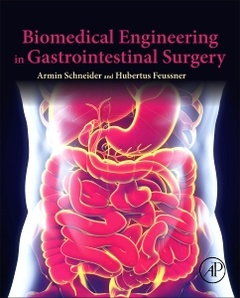Description
Biomedical Engineering in Gastrointestinal Surgery
Authors: Schneider Armin, Feussner Hubertus
Language: English
Subject for Biomedical Engineering in Gastrointestinal Surgery:
Keywords
AESOP; Academic emancipation; Acoustic tracking; Anesthesia; Antisepsis; Basic surgical principles; Biomedical engineering; Box trainer; Cancer; Clips; Cognitive surgery; Combined laparoscopic-endoscopic procedures; Computed tomography; Computer-assisted surgery; Confocal laser scanning; DaVinci; Definition of visceral surgery; Depth map; Diagnostic imaging; Disinfection; Education; Electromagnetic tracking; Electrosurgery; Endoscopic graspers; Endoscopic retrograde cholangiopancreatography (ERCP); Fiber bragg grating; Gastrointestinal anatomy; Gastrointestinal electrical stimulation; Health informatics; Hernia; History of surgery; Hospital information system; Hybrid surgery; Instrument reprocessing; Interventional flexible endoscopy; Laparoscopic instruments; Laparoscopic trolley; Magnetic resonance imaging; Malfunction; Master-slave systems; Mechatronic support systems; Minilaparoscopy; Mono-port surgery; Multimodal therapy; Natural orifice transluminal endoscopic surgery NOTES; Navigation; Open surgery; Operating room; Operative endoscopy; Optical coherence imaging; Optical tracking; Picture archiving and communication system; RFID; Rendezvous surgery; Rigid endoscopes; Robotic camera control; Robotic surgery; Smart implants; Snare; Stapling devices; Stents; Steps of a surgical operation; Structure of surgical care; Structured light; Surgical indications; Surgical instruments; Surgical meshes; Surgical organization; Surgical training manikins; Suture materials; TNM system; Teleconsulting; Telesurgery; Time-of-flight; Tracking; Tradition of engineering; Training; Translational research; Ultrasound; Ultrasound tissue dissection; Virtual reality trainers; Water jet tissue dissection; Waterjet tissue dissection; Wound healing; X-ray; ZEUS
204.32 €
In Print (Delivery period: 14 days).
Add to cartSupport: Print on demand
Description
/li>Contents
/li>Biography
/li>Comment
/li>
Biomedical Engineering in Gastrointestinal Surgery is a combination of engineering and surgical experience on the role of engineering in gastrointestinal surgery. There is currently no other book that combines engineering and clinical issues in this field, while engineering is becoming more and more important in surgery. This book is written to a high technical level, but also contains clear explanations of clinical conditions and clinical needs for engineers and students. Chapters covering anatomy and physiology are comprehensive and easy to understand for non-surgeons, while technologies are put into the context of surgical disease and anatomy for engineers.
The authors are the two most senior members of the Institute for Minimally Invasive Interdisciplinary Therapeutic Interventions (MITI),which is pioneering this kind of collaboration between engineers and clinicians in minimally invasive surgery. MITI is an interdisciplinary platform for collaborative work of surgeons, gastroenterologists, biomedical engineers and industrial companies with mechanical and electronic workshops, dry laboratories and comprehensive facilities for animal studies as well as a fully integrated clinical "OR of the future".
1. Surgery and biomedical engineering2. Anatomy and physiology of the gastrointestinal tract: specific considerations3. Principles of gastrointestinal surgery4. Preconditions of successful (gastrointestinal) surgery5. Diagnostic procedures6. Classical (open) surgery7. Operative (surgical) laparoscopy8. Interventional flexible endoscopy9. Combined laparoscopic-endoscopic procedures and natural orifice transluminal endoscopic surgery (NOTES)10. Mechatronic support systems and robots11. Future OR environment for visceral intervention12. Tracking and Navigation Systems13. Hospital Information Systems14. Training and simulation
Professor Feussner is a senior consultant surgeon who has been doing minimally invasive surgery for 30 years. He is a pioneer in laparoscopic and minimally invasive surgery which he introduced into clinical practice in 1989.
In 1999, Professor Feussner established the Institute for Minimally Invasive Interdisciplinary Therapeutic Interventions (MITI). He is the Secretary General of the Section for Computer and Telematic Assisted Surgery (CTAC) of the German Surgical Society since 2001 and of the German Society for Dysphagia (DGD). He is an Honorary Member of the Hungarian Society of Surgeons and other international surgical societies. He has authored more than 300 peer reviewed articles and holds 9 international patents.
- Written by the head of the Institute of Minimally Invasive Interdisciplinary Therapeutic Intervention (TUM MITI) which focusses on interdisciplinary cooperation in visceral medicine
- Provides medical and anatomical knowledge for engineers and puts technology in the context of surgical disease and anatomy
- Helps clinicians understand the technology, and use it safely and efficiently

